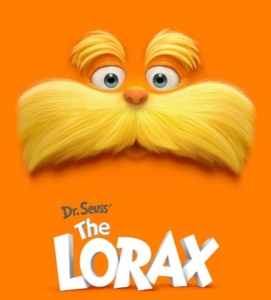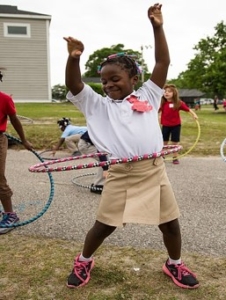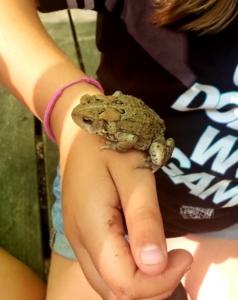“Limits to Growth”: A Game for Elementary School and Summer Camp
by Kayla Downs
I spend my summers working at a summer camp in Upstate New York. For a reason unbeknownst to me this past summer, my campers became obsessed with the song “Let It Grow” from The Lorax. They asked me to play it constantly, knew all the words, and loved to sing along. I didn’t realize how relevant it would become to my own life and work.

The Lorax (2012) film poster. (CC BY-NC-ND 4.0, Cliparts)
The Lorax by Dr. Suess (1971) is perhaps the most famous fable about the dangers of humans’ destruction of the natural environment. The 2012 movie adaptation of The Lorax tells the colorful story of a boy who discovers the conflict between the Lorax, who “speaks for the trees,” and the Once-ler, who chopped down all the Truffula trees in greed. The Lorax is a top-rated children’s movie and is often shown in elementary and middle school science classes. It fits into the climate change and environmental protection curriculum, yet the link between the economy and the environment is seldom enforced past the movie. The greed of the Once-ler was bad, but what system was in place that led to his actions?
So, it seemed serendipitous when I was asked by CASSE, as part of my internship, to help develop their “Limits to Growth” game. My charge was to flesh out the details of the outdoor version of the game, such that it would be engaging for the youngest of schoolkids while teaching them clearly about limits to growth. The game would reinforce lessons from The Lorax about greed, growth, and the gradual erosion of nature.
“Limits to Growth” can be played with elementary students in a school, after-school, or summer camp setting. In addition to reinforcing the The Lorax, the intent is to introduce kids to the most basic concepts of the economy, sustainability, and fairness, before the kids encounter the pro-growth bias of neoclassical economics in middle school.
“Limits to Growth” – Game Instructions
Game time: approx. 30 minutes
Materials needed:
- Hula hoops (minimum of two per student; extras ideal)
- Rope (for delineating the “planet’s” boundaries)
- Field, lawn, or gymnasium
Setup:
- Create a “planet” (circle on the grass) with the rope, about 20 ft. in diameter (for a twelve-student game).
- Give each student one hula hoop (this is their “house”), tell them to place it on the planet and stand in it.
- Name the planet with your students (any name they want).
- Tell the students the grass outside of their hula hoops represents nature (forests, ocean, animals, with props if available).
Round One:
- Pick two students at random to have a hula-hoop contest (alternatively, they can play rock-paper-scissors, if they are too young to hoop). The winner (whoever can hoop the longest) gets to choose an upgrade. The upgrades are the additional hula hoops allocated by the teacher, and they represent a vacation house, car, etc.
- Once they choose an upgrade, the student places the new hula hoop next to their original hoop and goes back to standing in their original hoop.

Who knew hula-hoops could be used for education as well as fun? (CC BY-SA 2.0, Ryan Johnson)
- The loser continues to stand in their lone hoop and will get another chance. The remaining students should stand in their hoops when not part of a contest.
- Repeat Step 1 until all the students have received an upgrade. There will still be a loser when there are only two students left without an upgrade. Make sure they receive an upgrade by some other scenario. (“Their luck changed, and they won the lottery!”)
- Repeat steps one and two until the students’ upgrades take up most of the planet’s grass area.
- Once they have filled up the planet, announce that a student has “died.” Make it funny and light-hearted; instruct the student to “dramatically die.” (Believe it or not, “dying” is a favorite of little kids at play.) Have two or three more students “dramatically die.”
- Ask the remaining students if they know why these students randomly died on their planet. Most likely, the students won’t have many guesses yet.
- Reset the game and play another round.
Round Two:
- Repeat round one, except the students do not have to upgrade this time; they can opt out. Pair different students together for the hula-hoop contests. If the students play this round similar to the first, let them.
- When all the green space gets used up, direct all the students to “die.”
- If they take fewer upgrades, ask them why.
- If some students are still taking upgrades while others are not, ask them if they think it is fair.
- If the students get to the point of using up all their space again, provide reasons for why the students died (ran out of food or water, dirty air, etc.).
- Ask the students if they have any guesses for why they died from those causes. If they do not have any guesses, tell them it was because they used up all the grass!
- Reset the game for the final round.
Final Round:
- Repeat the game with the option of not having to take an upgrade.
- Hopefully, the students will behave differently instead of using up all their grass.
- If the students conserve their space, announce that they have all stayed alive and won the game!
Debrief:
- Explain to the students that they had to conserve nature to survive.
- Explain the word “economy” as people and their stuff, including their hula-houses and cars.
- Explain that if we have too many houses and cars—too big of an economy—we lose nature and eventually can’t survive. There must be “limits to growth.” If we focus on protecting nature—not letting the economy get too big—everyone can stay alive and live “sustainably.”
- Ask the students if they think it’s fair if only some students get the upgrades while others don’t. Most students will realize it wouldn’t be fair. Fair versus unfair is an excellent time to introduce the idea of “equity.”
Children Can Understand Population and Consumption Issues
Teaching a child about economic themes such as population, consumption, and resources can be challenging. Children have observed their parents’ habits and beliefs throughout their lives and have often not been exposed to other worldviews. This teaching challenge is confounded when a school or camp serves children from many socioeconomic backgrounds (though it still isn’t as hard as talking to adults about population stabilization).

Children can understand what overcrowding looks like. (CC BY-SA 4.0, B137)
One way to introduce the population issue to elementary-aged children is to use examples from their own life. A good time to do this is immediately after playing “Limits to Growth.” Prompt the students to think of a time where they were in a crowded space—maybe a long line at an amusement park or stuck in traffic. They will probably say it made them feel annoyed, mad, and frustrated. Ask them how they think the planet would feel in the same situation. “How do you think all the animals would feel if they had to squeeze into a tiny little place because humans took up all their land?!”
Kids understand the basic meaning of numbers long before learning arithmetic. Share the fact that we have 7.8 billion humans on the planet; billions more than when their parents were kids. Note that, by the time they are adults, we could have nearly another two billion.
Children can learn simple phrases at a surprisingly early age, too. Get them thinking about people and stuff (hoola-stuff for now) as “the economy,” which can grow, shrink, or stay in a “steady state.” Talk about the human body as an example of a steady state. They know their bodies are growing, but their parents are not growing anymore; things do not grow forever! These visuals should help the students understand the issues that come with a growing population and economy.
Kids Love Nature
“Limits to Growth” models that each house and car added to the planet directly takes the space of nature. The game also encourages the students to realize that there is no trick or secret to winning—they only have to maintain enough green space, and nobody will die. Students are familiar with the concept of nature being trees and animals at the elementary school age. Children are very empathetic and will anthropomorphize animals. It is beneficial to use the term nature in “Limits to Growth” rather than “natural resources,” although the latter may be tossed in once or twice for good measure.

One of my happy campers with an American Toad. (Kayla Downs)
Humans inherently feel connected to nature: “biophilia,” as E.O. Wilson called it. Yet our society and economy seem designed to disconnect people from the Earth. We spend most of our time inside, looking at a screen, or in a car. Compared to our ancestors, we are far less exposed to nature. There is a whole field dedicated to understanding the impacts of this on children and adults, but if we encourage the connection to nature that kids heartily exhibit, that’s a good start. I see it first hand as a camp counselor.
Luckily my camp is primarily outdoors. We spend our days in the woods, playing in the field, or swimming in the lake. My campers could entertain themselves for hours by catching frogs and building forts.
Love of nature should be nurtured in elementary school, and it can be shaped into environmental protection and resource conservation in middle and high school. If my campers knew nature was in immediate danger, they would understand the need for action. We need to be teaching children that nature all around the world is in trouble, but in a way that promotes a solution and not despair; “Limits to Growth” can help us do that.
One game will not teach children everything they need to know about how to live a sustainable life, but it’s a start. Science classes in most places have begun to comprehensively teach climate change and threats to the environment from human impacts, but the real cause, unbounded GDP growth, is not addressed. Children need to understand the non-negotiable importance of environmental protection early on. This will lead to the questioning of conventional economics as they learn.
Alternatives to the growth narrative need to be taught during or before the earliest economics lessons. I took AP Environmental Science in high school, and the fact that economic growth was the root of environmental problems was not even mentioned. That’s a problem, and the next generation of students should be able to question it with confidence. Confidence grows with early exposure to alternative ideas through activities like “Limits to Growth.”





Herald readers are probably all thinking, “Great idea,” and maybe, “Long overdue!” It won’t be controversial, so few comments are likely, despite this article already achieving above-average readership.
That said, the challenge is now for supporters to forward this article to their local schools, school boards, summer camps, and any individual teachers they may know. Let’s get students learning about limits to growth—in the explicit terms of the economy—before they fall under the influence of outdated economics with its “fairy tale of eternal economic growth,” as one famous student put it.
Cool idea – I’ll try to keep alert to opportunities to pass the game along. I think it’s true that children often are more empathetic to animals, so maybe that will help.
Great Post! Thank you for sharing useful information. We are also a provider of Sleepaway Camps in NY. Visit our website for more info: https://brookwoodcamps.com/
It’s fantastic to see environmental education addressed through interactive games like “Limits to Growth,” which can effectively engage kids on topics of sustainability and fairness. This hands-on approach connects them with the impact of their actions in a tangible way, similar to how we incorporate respect, discipline, and empathy through martial arts. Games like these offer a memorable way for children to grasp the importance of conservation, just as learning self-control through Taekwondo or Karate can teach them balance and responsibility.